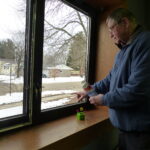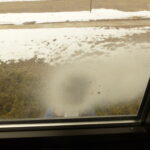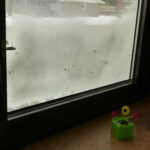Why Do Birds Hit Windows?
*Note: Our assessment of WindowAlert is based on our experiences both from purchasing the company’s product and a complimentary set of decals to try.
Last fall as Rich was walking along the outside of the Cedar Rapids Public Library and found a tiny dead warbler on the sidewalk beneath a large window. Fall warblers are tough to identify but it was a blackpoll. Why did the bird hit the window?
This amazing bird has an enormous migration from the far north of the continent to the south each fall, with a reverse trip in the spring. The bird Rich found probably was only halfway through its autumnal journey. Its death was sad and probably could have been prevented.
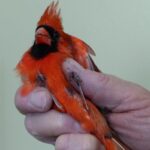
Cardinal
Occasionally we have a bird crash against our windows at Winding Pathways, and a male cardinal persists in cracking his head against a window at our church in Cedar Rapids.
Bird numbers are declining at an alarming rate for many reasons. Certainly, habitat loss and climate change are taking a toll. Feral cats and windows also kill millions of birds every year. Some of that loss can be prevented.
Why Birds Are Killed by Windows?
According to Spencer Schock at WindowAlert, birds are impacted by windows for two reasons. First, all year, but especially during migration, birds simply don’t see the glass and assume they can fly right through it. That’s what happened to the warbler. Second, it’s springtime rivalry. The cardinal banging on the church window sees his reflection, assumes it is a rival and tries to chase it off or intimidate it. This behavior is common, especially among cardinals, and usually happens from late winter into early spring. It’s rarely fatal to the bird but can annoy humans inside the building.
How to Reduce Bird Strikes on Windows.
The simple solution for both types of bird strikes is to do something so the animal recognizes it is glass. Here are some ways to reduce window strikes:
- Close Drapes. But then people can’t see out and sunshine can’t enter.
- Put something over the exterior window that looks to birds like a barrier or physically keeps them away. Draping the mesh netlike material made to protect cherry trees from birds trying to steal fruit works. The downside is that sometimes birds get tangled in it.
- Put decals on the windows to help birds identify a glass barrier. We like the many designs sold by WindowAlert. They’re easy to apply, attractive, inexpensive and work well.
- Eliminate reflection to keep cardinals and other territorial birds from attacking their own image. WindowAlert has a material called Stop Bird Attack. It comes in a spray can that’s sprayed on the outside of the window. The material looks like white flocking put on Christmas trees to imitate snow. It eliminates reflection and can be easily cleaned off the window after the mating season.
- Check the windows first.
- Ready to spray
- The spray makes the window opaque.
- The BirdStop spray resembles Christmas tree flocking.
What to Do When a Bird is Found under a Window
A few times we’ve been sitting in our home and hear a bang as a bird strikes a window. We sadly find the poor animal lying still under the window. There are two likely outcomes.
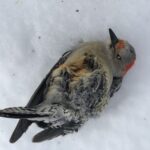
This bird broke its neck hitting a window.
The bird is either dead or dying and there’s nothing we can do to alter that unhappy outcome. e bury the poor creature and add more visibility items to the window.
The bird has been stunned and will soon recover and fly away. Often a bird will recover, but while it is stunned it’s vulnerable to cats and other predators. Spencer advises gently putting the bird in a closed cardboard box or large paper bag. As soon as it has recovered, release it outdoors.
Probably the best thing a homeowner can do to help songbirds is to plant a diversity of native grasses, flowers, shrubs, and trees to create habitat. The next best action is to keep cats indoors and reduce the odds of collisions with glass using the methods described above.

